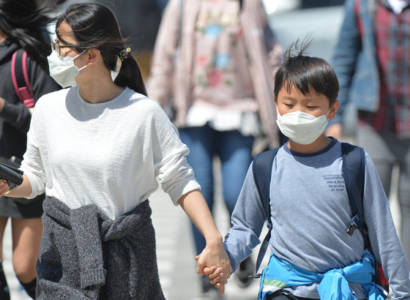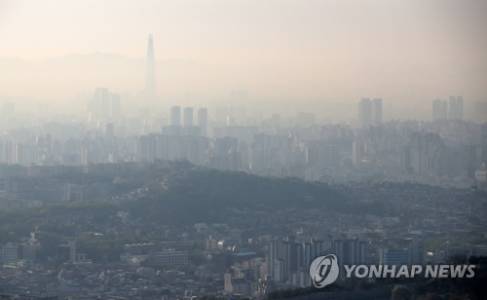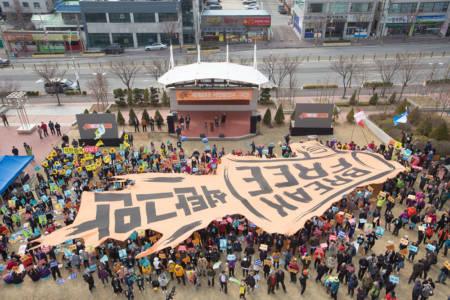By Sea Jin Kim, GEYK (Green Environment Youth Korea)
Korea is suffering from particulate matter particularly this spring. People cannot go outside without wearing a mask, and for sure, mothers cannot bring their babies outside for a walk. Every morning, I was checking the particulate matter forecast, and started to wear the special mask designed for blocking particulate matter.

Source: News1: http://news.mt.co.kr/mtview.php?no=2017042016485546441&outlink=1&ref=
A resident living near a coal-fired power plant said, “The smell of gas and ultrafine particles from the coal power plant causes headache and coughs. In severe cases, I cannot sleep at night because of headache and vomiting. I did not ask for the stop of the operation of the thermal power plant. When I make a complaint to reduce the smell and ultrafine particles, the employees of the power plant threaten and conciliate.”
Particulate matter is a primary carcinogen called ‘silent assassin’. Particulate matter is composed of various carcinogens, environmental hormones and heavy metals. The size of the particles is very small, about 5 to 30 times smaller than the thickness of the hair. They are not weeded out in the bronchial tubes but enters the alveoli, which ultimately let the particles go into the blood. It floats to cause inflammation and various diseases. Furthermore, the World Health Organization (WHO) evaluated and classified particulate matter which is a major component of outdoor air pollution as carcinogenic to humans (Group 1) in 2013. According to the WHO, the number of premature deaths due to fine dust in 2014 is 7 million, which is more than the number of premature deaths from smoking (6 million).

Source: Yonhap News: http://www.yonhapnews.co.kr/bulletin/2017/04/21/0200000000AKR20170421008500004.HTML?input=1195m
The problem is that the concentration of particulate matter in Korea is higher than that of developed countries such as USA, Europe and Australia. According to the US Environmental Health Association (HEI) data, the average concentration of particulate matter 2.5 (PM 2.5) in Korea in 2015 is 29 μg/㎥, which is three times that recommended by the World Health Organization (10 μg/㎥).
Also, according to the data from the National Institute of Environmental Research, even if the PM2.5 measurement stations increased from 124 in 2015 to 185 in 2016, there was no place that met the reference value of 25 μg/㎥ (24 hour average concentration). Furthermore, there was no PM10 measurement station in South Korea which passed the WHO environmental standard.
According to the OECD report in 2016, if Korea cannot cope with air pollution such as particulate matter, it will be the country with the highest premature death rate due to particulate matter after 40 years. Also, Tsinghua University in China and international researchers have published a study on the effect of ultrafine dust (PM2.5) on the early mortality rate on the International Journal of Nature on March 29. In 2007, the number of premature deaths in East Asia, including Korea and Japan, reached 30,900. From the study, Korea is expected to have the highest rate of early death from air pollution among OECD member countries by 2060.
Coal power plants are responsible for particulate matter. According to the Ministry of Environment of South Korea, power plants directly account for 14% of the domestic sources of PM 2.5. However, what is important is that NOx and SOx in the air cause chemical reactions to generate ‘secondary particulate matter’. Although the secondary particulate matter contributes a great deal, the problem is that it is not easy to collect statistics properly.
More than half of the 59 coal-fired power stations in Korea are in the Chungnam area. Among them, 10 thermal power plants in operation in Dangjin are the largest in the world at 6,040 MW. Most of the Dangjin residents are opposed to further construction, saying that if additional thermal power plants are constructed under such circumstances, there will be more negative impacts on the residents’ health.
On March 25, around 1,000 citizens joined the ‘Break Free’ in South Korea to oppose the plan to build two more coal power plants in Dangjin and to shift to renewable energy. The event was co-organized by Dangjin Citizens’ Commission Against Power Line & Coal-Fired Power Plant, Greenpeace, Korea Federation for Environmental Movement, GEYK, and 350.org East Asia.

Source: The Hankyoreh: http://www.hani.co.kr/arti/society/area/788017.html
Still, 11 power plants (9764 MW) of coal-fired power plants are being constructed in Chungcheongnam-do, Gangwon-do, Gyeongsangnam-do, Jeollanam-do and Incheon. In addition, 13 (12,100 megawatts) will be constructed soon. When all of the power plants planned by 2020 are completed, a total of 48,218 MW and 77 coal-fired power plants will be installed in Korea. No wonder the problem from particulate matter is becoming worse.
